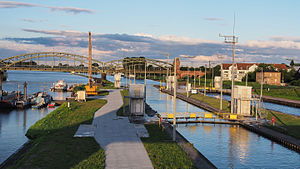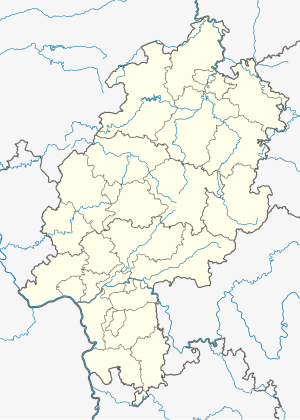Kostheim barrage
| Kostheim barrage | ||
|---|---|---|
| Kostheim barrage with railway and motorway bridges in the background | ||
| location | ||
|
|
||
| Coordinates | 50 ° 0 ′ 1 ″ N , 8 ° 20 ′ 3 ″ E | |
| country |
|
|
| place |
Ginsheim-Gustavsburg ( GG ) Hochheim am Main ( MTK ) |
|
| Waters | Main | |
| Kilometers of water | km 3.209 | |
| Height upstream | 83.92 m | |
| power plant | ||
| owner |
|
|
| operator | HPP barrage Kostheim / Main GmbH & Co. KG | |
| Start of planning | 2002 | |
| construction time | November 2007 to September 2009 | |
| Start of operation | before October 19, 2009 | |
| technology | ||
| Average height of fall |
3.00 m | |
| Expansion flow | 160 m³ / s | |
| Turbines | 2 Kaplan turbines | |
| Others | ||
| was standing | August 30, 2012 | |
The Kostheim barrage is the first barrage coming from the Rhine on the Main, or the last of the 34 Main barrages . It is the most heavily used lock on the Main and, along with the Iffezheim am Rhein barrage, it is the busiest inland lock in Germany. It is subordinate to the Aschaffenburg Waterways and Shipping Office . The central tax collection point for commercial inland navigation has also been located there since 2010/11 . For the recreational marine environment , the use of locks is free of charge.
The barrage is located in Main-km 3.209 at a height of 83.92 meters above sea level , the impoundment is up to the barrage Eddersheim 12.342 km. The average fall height is 2.36 meters, as this depends on the level of the Rhine.
Naming
Although the lock bears the name of the nearby Wiesbaden district of Kostheim , it is on the left-hand side of the Main in Ginsheim-Gustavsburg , the hydropower plant is on the right-hand side of the Main in Hochheim am Main .
history
There was a needle weir from 1886. The Kostheim barrage , built between 1930 and 1934 in the New Objectivity style, is three kilometers above the Mainspitze . On April 1, 1933, today's lock was put into operation. The barrage, which was completed a year later, has three roller weirs to dam the Main. The difference in altitude is 3.74 meters. The two lock chambers are 342 and 339 meters long. The Kostheim barrage is one of the busiest inland locks in the German waterway network. Every day they pass 65 to 75 ships to transport cargo such as mineral products and gases as well as stones and earth on Europe's waterways.
The Kostheim barrage has been part of the Rhine-Main Industrial Culture Route since the 2000s . It belongs to the Wiesbaden section . Nearby is the Hochheim railway bridge , which belongs to the Mainspitze section .
Control center
The control center Kostheim has been located at the lock since August 19, 2012 (day of inauguration). There, the professional skippers have to pay the shipping tax for the passage of the Main and the Main-Danube Canal, 384 kilometers away . The fee is calculated according to the three factors:
- Cargo (the higher quality and more dangerous, the more expensive)
- tonnage
- Route length
- No guarantee: passenger ships pay for the occupied passenger beds and the length of the route. Ships sailing without passengers are tax-free.
The control center has been responsible for the Kostheim and Griesheim locks since it opened . In the spring of 2013, the Eddersheim barrage in between was added.
technology
Barrage
The Kostheim barrage is a roller weir built by the neighboring MAN plant in Gustavsburg with a weir width of three times 33.30 meters clear width and a maximum fall height of 3.50 meters (the height depends on the Rhine level). If the Rhine floods, the rollers can be pulled completely out of the Main and the ships can drive through the barrage. The barrage is equipped with a fish ladder on the right side of the Main .
Lock and inland shipping
The Main is classified in the European waterway class Vb and navigable for ships or push convoys with a length of 185 meters and a width of 11.45 meters. The fairway is at least 2.90 meters deep all year round.
The locks, which are operated around the clock, enable smooth shipping. Currently (as of 2012) around 21,000 freight ships with around 20 million tons pass through the Kostheim lock every year. A worldwide future-oriented technology on the waterway was introduced with the remote control of locks. A control center operates up to four, but a maximum of ten, locks up to 120 kilometers away. In addition to optimizing lock operation, the aim was also to extend lock operating times for inland shipping. The Kostheim lock is controlled by the Kostheim control center. The ends of the lock can be viewed through video cameras as if from the actual control station. The responsible shift supervisor is responsible for safety, he controls and monitors the entire smuggling process.
The barrage has two locks with three chambers and a boat lock:
- the south chamber with a usable length of 339.02 meters and a usable width of 20.00 meters, whereby the gate is only 12.00 meters wide, was put into operation in 1933. The water throughput per lock is 19,000 m³. It is the oldest of the two locks and is also known as the “banana lock” because of its curvature. The wider chamber size is due to the chain shipping on the Main , at that time the barges were moored next to each other in the lock in order to transport the long towing convoys in one lock process. A renovation took place in 1965.
- the north chamber was opened in 1935 with a length of 341.90 meters and a width of 15.00 meters. The water throughput there is 15,500 m³ per lock. If necessary, the north chamber can be divided into two individual chambers (upper chamber: 112 meters, lower chamber: 229 meters). This is necessary when people and dangerous goods ships are locked at the same time, as both may not lie in the same chamber.
- the boat lock is 21.90 meters long and 3.50 meters wide. It must be operated by the boatmen themselves.
In front of the lock chambers there is a 500 meter long upper and lower pre-channel in which ships can wait for the lock. On the mountain side, the pre-channel begins under the motorway bridge . The facility, through which around 65 to 75 ships pass daily, is manned and in operation around the clock.
traffic
| year | Cargo ships | Passenger ships | Volume of goods in freight bins | Standard container |
|---|---|---|---|---|
| 1933 | ... | ... | ... | ... |
| ... | ... | ... | ... | ... |
| 2014 | 15,960 | 1,191 | 15,704,666 | 84,520 |
| 2015 | 15,779 | 1,225 | 13.985.605 | 79.128 |
| 2016 | ... | ... | ... | ... |
There is no information available about the pleasure boats that were manually operated by the boatmen. A good 40 percent of the ships smuggled in in 2014 and 2015 carried the German and Dutch flags. The groups of goods with the most tonnes of goods were rock, earth and building materials on the mountain, followed by mineral oil products; on the valley floor it was agricultural and forestry products, followed by other food and feed.
Maintenance walkway
The footbridge made of grating above the lock rollers is designed only as a maintenance footbridge and is used by the WSV staff and the ship's crews. Use by pedestrians is only tolerated. There is no right of passage.
Hydroelectric power plant
The hydropower plant was built by Stadtwerke Ulm / Neu-Ulm (70%) and hallechkraftwerke Einsiedler from Memmingen (30%) in 2009 and has been operated by their joint subsidiary WKW Staustufe Kostheim / Main GmbH & Co. KG since its completion in 2011.
The height of fall of the water depends on the water level of the Rhine. The average height difference is 2.36 m. Two Kaplan -pit bulb turbines generate an output of 4960 kilowatts. The annual production for the Stadtwerke Ulm amounts to 12.9 million kilowatt hours.
The newly built fish ladder came under fire shortly after the hydropower plant was commissioned because it was not working properly. A long-term scientific study on patency published in 2012 finally proved the serious deficiencies in the functioning of the fish passages and fish passages.
literature
- Martin Frey: Mainz-Kostheim hydropower plant: Active protection of the fish world paired with modern technology ; in: Hydropower & Energy; ISSN 0947-5036 ; Vol. 16, No. 1, 2010; Pp. 23-29
Individual evidence
- ↑ Control centers - traffic safety around the clock ( Memento from March 4, 2016 in the Internet Archive ) Status: 5/2011 PDF file
- ↑ Schleuse Kostheim: Insights into the new control center / shipping - At the open day, many visitors take a look behind the scenes of arc on echo-online.de on August 20, 2012
- ↑ General Directorate for Waterways and Shipping - Branch Office South-: Traffic Report 2014/2015 ( Memento from June 5, 2017 in the Internet Archive ) Pages 90–94 and 115 of the PDF file 4.59 MB
- ↑ A new hydropower plant on the Main - This is how it works in times of the liberalization of the energy supply: Not domestic energy suppliers, but the Ulm / Neu-Ulm municipal utilities have built a hydropower plant on the Main. by Ewald Hetrodt on faz.net from October 15, 2009
- ↑ Numerous interested parties on a guided tour through the construction site of the hydropower plant between Hochheim and Kostheim ( Memento from July 28, 2014 in the Internet Archive ) Status: 2009
- ↑ SWU will open power plant on the Main from October 19, 2011 on augsburger-allgemeine.de
- ^ The hydropower plants of the SWU ( Memento of February 5, 2015 in the Internet Archive ) online on the Internet: July 20, 2014
- ^ Many fish are dying in the Kostheim hydropower plant ( Memento from July 29, 2014 in the Internet Archive ) Frankfurter Rundschau
- ^ Hydropower plant Kostheim am Main: Catastrophic conditions on blinker.de from August 9, 2012
- ↑ Salmon Project
Web links
- Kostheim lock
- The Main lock in Gustavsburg
- Basic repairs to weir pillars, Kostheim barrage
- Pictures of the roller weir during flooding: picture 1 picture 2
- Hydroelectric power plant
- Datasheet hydroelectric power station Kostheim


